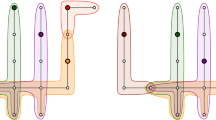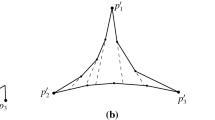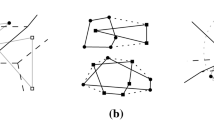Abstract
Abstract Voronoi diagrams [15,16] are based on bisecting curves enjoying simple combinatorial properties, rather than on the geometric notions of sites and distance. They serve as a unifying concept. Once the bisector system of any concrete type of Voronoi diagram is shown to fulfill the AVD axioms, structural results and efficient algorithms become available without further effort; for example, the first optimal algorithms for constructing nearest Voronoi diagrams of disjoint convex objects, or of line segments under the Hausdorff metric, have been obtained this way [18]. One of these axioms stated that all Voronoi regions must be pathwise connected, a property quite useful in divide&conquer and randomized incremental construction algorithms. Yet, there are concrete Voronoi diagrams where this axiom fails to hold.
In this paper we consider, for the first time, abstract Voronoi diagrams with disconnected regions. By combining the randomized incremental construction technique [18] with trapezoidal decomposition [21] we obtain an algorithm that runs in expected time \(O(s^2 n \sum_{j=3}^n {{m_j}/{j}})\), where s is the maximum number of faces a Voronoi region in a subdiagram of three sites can have, and m j denotes the average number of faces per region in any subdiagram of j sites. In the connected case, where s = 1 = m j , this results in the known optimal bound \(O( n \ \sum_{j=3}^n 1/j) \ = \ O(n \log n)\).
This work was supported by the European Science Foundation (ESF) in the EUROCORES collaborative research project EuroGIGA/VORONOI.
Access this chapter
Tax calculation will be finalised at checkout
Purchases are for personal use only
Preview
Unable to display preview. Download preview PDF.
Similar content being viewed by others
References
Abellanas, M., Hurtado, F., Palop, B.: Transportation Networks and Voronoi Diagrams. In: Proceedings of the International Symposium on Voronoi Diagrams in Science and Engineering (2004)
Agarwal, P.: Personal Communication (2012)
Ahn, H.-K., Cheong, O., van Oostrum, R.: Casting a Polyhedron with Directional Uncertainty. Computational Geometry: Theory and Applications 26(2), 129–141 (2003)
Aichholzer, O., Aurenhammer, F., Palop, B.: Quickest Paths, Straight Skeletons, and the City Voronoi Diagram. Discrete and Computational Geometry 31(7), 17–35 (2004)
Aurenhammer, F.: Voronoi Diagrams: A Survey of a Fundamental Geometric Data Structure. ACM Computing Surveys 23(3), 345–405 (1991)
Aurenhammer, F., Klein, R.: Voronoi Diagrams. In: Sack, J.R., Urrutia, G. (eds.) Handbook on Computational Geometry, pp. 201–290. Elsevier (1999)
Aurenhammer, F., Klein, R., Lee, D.-T.: Voronoi Diagrams and Delaunay Triangulations. World Scientific Publishing Company (to appear in August 2013)
Bae, S.W., Chwa, K.-Y.: Voronoi Diagrams for a Transportation Network on the Euclidean Plane. International Journal on Computational Geometry and Applications 16, 117–144 (2006)
Boissonnat, J.D., Wormser, C., Yvinec, M.: Curved Voronoi Diagrams. In: Boissonnat, J.D., Teillaud, M. (eds.) Effective Computational Geometry for Curves and Surfaces. Mathematics and Visualization. Springer (2006)
Bohler, C., Cheilaris, P., Klein, R., Liu, C.-H., Papadopoulou, E., Zavershynskyi, M.: On the Complexity of Higher Order Abstract Voronoi Diagrams. In: Fomin, F.V., Freivalds, R., Kwiatkowska, M., Peleg, D. (eds.) ICALP 2013, Part I. LNCS, vol. 7965, pp. 208–219. Springer, Heidelberg (2013)
Bohler, C., Klein, R.: Point Sites with Individual Distance Functions, Bonn (2012), http://www.i1.informatik.uni-bonn.de/sites/default/files/ManyDist.pdf (manuscript)
Clarkson, K., Mehlhorn, K., Seidel, R.: Four Results on Randomized Incremental Constructions. Computational Geometry: Theory and Applications 3, 185–212 (1993)
Fortune, S.: Voronoi Diagrams and Delaunay Triangulations. In: Goodman, J.E., O’Rourke, J. (eds.) Handbook of Discrete and Computational Geometry, ch. 20, pp. 377–388. CRC Press LLC (1997)
Karavelas, M.I., Yvinec, M.: The Voronoi Diagram of Planar Convex Objects. In: Di Battista, G., Zwick, U. (eds.) ESA 2003. LNCS, vol. 2832, pp. 337–348. Springer, Heidelberg (2003)
Klein, R.: Concrete and Abstract Voronoi Diagrams. LNCS, vol. 400. Springer, Heidelberg (1989)
Klein, R., Langetepe, E., Nilforoushan, Z.: Abstract Voronoi Diagrams Revisited. Computational Geometry: Theory and Applications 42(9), 885–902 (2009)
Klein, R., Mehlhorn, K., Meiser, S.: Randomized Incremental Construction of Abstract Voronoi Diagrams. Computational Geometry: Theory and Applications 3, 157–184 (1993)
Mehlhorn, K., Meiser, S., Ó’Dúnlaing, C.: On the Construction of Abstract Voronoi Diagrams. Discrete and Computational Geometry 6, 211–224 (1991)
Mehlhorn, K., Meiser, S., Rasch, R.: Furthest Site Abstract Voronoi Diagrams. International Journal of Computational Geometry and Applications 11(6), 583–616 (2001)
Okabe, A., Boots, B., Sugihara, K., Chiu, S.N.: Spatial Tessellations: Concepts and Applications of Voronoi Diagrams. Wiley Series in Probability and Statistics (2000)
Seidel, R.: A Simple and Fast Algorithm for Computing Trapezoidal Decompositions and for Triangulating Polygons. Computational Geometry: Theory and Applications 1, 51–64 (1991)
Sharir, M., Agarwal, P.: Davenport-Schinzel Sequences and Their Geometric Applications. Cambridge University Press (1995)
Author information
Authors and Affiliations
Editor information
Editors and Affiliations
Rights and permissions
Copyright information
© 2013 Springer-Verlag Berlin Heidelberg
About this paper
Cite this paper
Bohler, C., Klein, R. (2013). Abstract Voronoi Diagrams with Disconnected Regions. In: Cai, L., Cheng, SW., Lam, TW. (eds) Algorithms and Computation. ISAAC 2013. Lecture Notes in Computer Science, vol 8283. Springer, Berlin, Heidelberg. https://doi.org/10.1007/978-3-642-45030-3_29
Download citation
DOI: https://doi.org/10.1007/978-3-642-45030-3_29
Publisher Name: Springer, Berlin, Heidelberg
Print ISBN: 978-3-642-45029-7
Online ISBN: 978-3-642-45030-3
eBook Packages: Computer ScienceComputer Science (R0)




